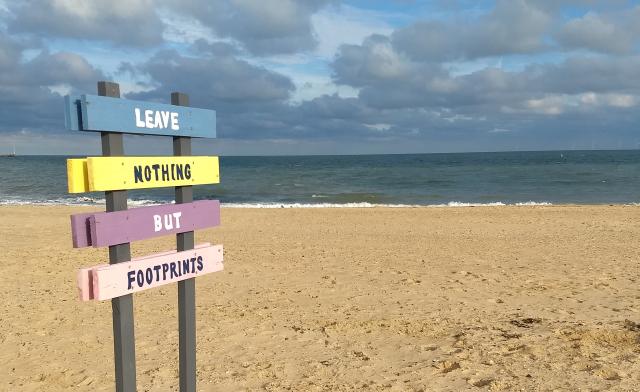With increasing awareness of humans’ negative impact on the environment, people are realising that new choices have to be made. Caroline Petherick, who has been living an eco-friendly lifestyle for well over a decade, has summarised the changes and decisions she has made to lower her carbon footprint and ecological impact.
 Here are the things I’ve been doing; some of them might appeal to you or turn into a springboard for something else you can do to reduce your carbon footprint.
Here are the things I’ve been doing; some of them might appeal to you or turn into a springboard for something else you can do to reduce your carbon footprint.
- Banking: The easiest of the lot, and one of the most effective: I have two savings accounts, a current account and a social enterprise account at Triodos Bank. I want to use a bank that truly supports ethical and sustainable enterprise and behaves in an ethical way itself.
- Working: My office is paperless, as much as possible. I’ve never worked on hard copy. I have a drawer called ‘scrap’ where I keep paper printed on one side only, then if I do need to print or write something, I use that rather than new paper. (Paper used on both sides helps light the wood burner – or it could be shredded and used in a compost bin.)
- House sharing: My house has three bedrooms, and now that my children have grown up I share it with others, who contribute towards the costs (the government Rent a Room Scheme allows £7,500 pa free of tax); the sharing provides company and means that my per person emissions are much reduced.
- Food: I share my house with vegans, and while I’m not vegan myself, I have found a vegan ‘cheese’ I’m happy with – Violife – along with my fave ever milk (Rice Dream with hazelnuts and almonds) – and so now I don’t consume any dairy. (No butter, either: I buy Feral Trade’s olive oil.) I also have a local organic veg box, and I shop in my local farm shop, fish shop and butcher (where I buy wild venison about once a fortnight). I do go to a supermarket occasionally – a high street Co-op – but only for rare and weird things like poppadoms and Nakd bars.
- House heating: In 2007, after my partner died suddenly, I took out the night storage heaters (too expensive to run), stacked their bricks up against an internal wall, and just in front of them, put a wood-burning stove made out of an old gas cylinder.
Until last year, that was the only heating in the house, and in winter, the temperature could drop to around 10 degrees in the early mornings. Last year, I cashed in a pension fund to buy Planitherm windows and patio doors, and their extra insulation and passive solar gain has made a huge and welcome difference. I also bought some infrared wall panels (only 300w!) to heat the building fabric, the furniture and the humans, not the air. That helps reduce the condensation and the concomitant mould. And recently, I added a couple of dehumidifiers; they produce some heat (again, they’re only about 300w each), but their main advantage is that because the air is drier, it doesn’t feel so cold. And the mould has gone. (But in winter, I’ll still be wearing my long johns, padded waistcoat, thick slippers and Bob Cratchit mittens to work in!)
- Cooking, washing, drying: The wood burner has a flat top (the gas bottle’s upside down), so in winter that’s good for cooking on. In summer, we use an induction hob. There’s also an electric fan oven that we use occasionally. The washing machine is A++ rated, and I use washballs, not detergent. We line dry when possible – there’s a rotary line behind the house, and in a 20-foot-long lean-to are three drying lines (plus firewood storage). The tumble dryer gets used when the washing’s been hanging out for a week and still isn’t dry.
- Cleaning: I have a limited selection of cleaning products, which can be used for cleaning just about everything: white vinegar, bicarb of soda and Ecover products.
- Water heating: The house has four large immersion heater cylinders, which were originally hooked into the Economy 7 night storage system, and I turned them off years ago. There are now two electric showers with instant hot water; for the wash basins and kitchen sink it’s cold water, and for washing up it’s a kettle on the wood burner in winter and an electric kettle in summer. Works fine!
- House lighting: We only have lights on in a room that someone’s in. Well, that’s the idea, anyhow. We find ourselves going round the house turning lights off after each other. We’ll get there in the end! Meanwhile, I use Bulb as my electricity supplier (we don’t have gas).
- Loo roll, kitchen roll: Always recycled. I hate the idea of putting trees – even trees grown as a crop – down the loo.
- Transport: One day I’ll buy an EV, when the second-hand prices have dropped far enough. (There are government grants available in the UK for the installation of EV charging points.) In the meantime, my car, a 2006 Nissan, constitutes by far the biggest element of my carbon footprint. But as I live a good hour’s walk from the nearest bus stop (two services a day) or railway station (four) and cycling here is suicide – death by brake failure on the downhills or by heart failure on the up – I’m going to keep running some sort of car for the foreseeable future. I car share as much as possible, and use the car to connect with railway trains from our local town. And from January onwards, for my overseas journeys, it’ll be surface only: no flights until there are proper sustainably fuelled aircraft. Long-distance rail is great! For bright ideas (and armchair travelling), check out the Man in Seat 61.
- I’ve started going to local council meetings, to push for action, not words. Result thus far? Well, while at the October meeting they told me that if I wanted do something useful I should write a piece for the parish magazine [ahem] in the November meeting, they agreed to get local people out, spade in hand, to plant trees. There are already regular litter picks, and now we’re pushing Cornwall Council to install solar PV in the local social housing estate. That’s a start!
- I’m a member of (and so subscribe to) humanitarian and planet-minded groups, including Amnesty International, Avaaz, 38 Degrees, Toilet Twinning, TreeSisters, the South West Coast Path Association, the National Biodiversity Network, the RSPB, the Woodland Trust and the Marine Biological Association.
Plus, I get (and read!) newsfeeds from the National Oceanography Centre, the Marine Conservation Society, the Met Office, and the NOAA (National Oceanic and Atmospheric Administration).
I support Global Citizen, SumOfUs, Whale and Dolphin Conservation, WWF, WaterAid, the CoaST Network (sustainable tourism), Open Democracy, Freedom United, Campaign Against Arms Trade, Friends of the Earth, Rainforest Rescue, Save the Whales and Greenpeace by signing their petitions and giving donations. - In September 2019, I went to the annual conference of the Centre for Alternative Technology (CAT) in Machynlleth. But you don’t need to wait for its next conference – just go there! Visit its website for ideas and inspiration: www.cat.org.uk
- At last I have another source of income: an old storehouse on my land that I’ve been converting over the years into a holiday cottage with a difference. It’s off-grid, so people can come and holiday by the sea and at the same time learn hands-on about living by using alternative energy sources – wood, and the sun (and I’m saving up for a small wind turbine). You could come and try living off-grid, too!
- Finally, there are loads more ideas in a book I edited – The Carbon Buddy Manual: your practical guide to cooling our planet by Dr Colin Hastings.
 In the early 1990s – before the days of websites – Caroline Petherick, with a partner and 4 young children in tow, somehow managed to find the then SfEP (now CIEP). Having taken its early copyediting courses, she’s never looked back, and now works for one publisher and a wide range of businesses and independent authors.
In the early 1990s – before the days of websites – Caroline Petherick, with a partner and 4 young children in tow, somehow managed to find the then SfEP (now CIEP). Having taken its early copyediting courses, she’s never looked back, and now works for one publisher and a wide range of businesses and independent authors.
Proofread by Alice McBrearty,.
Posted by Abi Saffrey, CIEP blog coordinator.
Photo credits: Leave nothing but footprints – Abi Saffrey; Iceberg and sky – Ruslan Bardash on Unsplash; Green growth – Matthew Smith on Unsplash
The views expressed here do not necessarily reflect those of the CIEP.



I already follow a few – sadly not all, yet – of these ideas, but one additional one is, when your printer next needs replacing, get one that prints double-sided and reduce further the paper you print out. I got one a few months ago and was surprised to see how much the prices had come down.
A bit late to this post, sorry! I admire the steps you’ve taken. Good effort.
Caroline, you’re a (slightly intimidating;)) inspiration! I’d no idea so much can be done to help reduce our footprint on the planet… For my part, I reuse plastic bags (I wash & dry them out first), and haven’t bought any plastic bags for at least a year now. I also buy most of my cosmetics from a company that recycles their used up containers, so that I can hand in my old bottles and cream pots to one of their shops for recycling. And I also print double-sided! (Can’t give up working on hard copy because of my eyesight, but double-sided is a compromise.) Thank you for sharing your incredible life skills.
Agree with Kasia, you are an inspiration, Caroline. Thank you for all these admirable ideas. I’m with you on the no-fly principle, and I doo love my virtual travels alongside the man in seat 61.
Has anyone reading this had better luck than me in finding out if / where one can recycle those Covid testing strips (the ones that develop a stripe for a positive test)? I’ve got a big stockpile of them that’s built up over the years, and I hate the thought of adding to the billions that must already be in landfill…